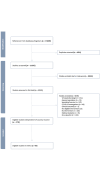Interventions to maintain essential services for maternal, newborn, child, and adolescent health during the COVID-19 pandemic: A scoping review of evidence from low- and middle-income countries
- PMID: 38867685
- PMCID: PMC11170233
- DOI: 10.7189/jogh.14.05024
Interventions to maintain essential services for maternal, newborn, child, and adolescent health during the COVID-19 pandemic: A scoping review of evidence from low- and middle-income countries
Abstract
Background: The coronavirus disease 2019 (COVID-19) pandemic had challenged health systems worldwide, including those in low- and middle-income countries (LMICs). Aside from measures to control the pandemic, efforts were made to continue the provision and use of essential services. At that time, information was not organised and readily available to guide country-level decision-making. This review aims to summarise evaluated interventions to maintain essential services for maternal, newborn, child, and adolescent health in response to COVID-19 in LMICs, in order to learn from the interventions and facilitate their use in the next disruption.
Methods: We conducted a scoping review by Embase, MEDLINE, and Global Health for literature published between 1 January 2020 and 26 December 2022, without restrictions for language. We extracted information about the setting, population targeted, service type, intervention, and evaluation from the included studies and summarised it both quantitatively and narratively.
Results: We retrieved 11 395 unique references and included 30 studies describing 32 evaluated interventions. Most interventions (84%) were implemented in 2020, with a median duration of five months (interquartile range (IQR) = 3-8), and were conducted in Africa (34%) or Southeast Asia (31%). Interventions focussed on maintaining services for maternal and newborn health (56%) or children and adolescents (56%) were most common. Interventions aimed to address problems related to access (94%), fear (31%), health workers shortage (25%), and vulnerability (22%). Types of interventions included telehealth (69%), protocols/guidelines to adapt care provision (56%), and health education (40%); a few entailed health worker training (16%). The described interventions were mostly led by the public (56%) or non-profit (34%) sectors. Methodologies of their evaluations were heterogeneous; the majority used quantitative methods, had a prospective research design, and used output- and outcome-based indicators.
Conclusions: In this review, we identified an important and growing body of evidence of evaluated interventions to maintain essential services for maternal, newborn, child, and adolescent health during COVID-19 in LMICs. To improve preparedness and responsiveness for future disruptions, managers for decision-makers in LMICs could benefit from up-to-date inventories describing implemented interventions and evaluations to facilitate evidence-based implementation of strategies, as well as tools for conducting optimal quality operational and implementation research during disruptions (e.g. rapid ethical approvals, access to routine data).
Copyright © 2024 by the Journal of Global Health. All rights reserved.
Conflict of interest statement
Disclosure of interest: The authors completed the ICMJE Disclosure of Interest Form (available upon request from the corresponding author) and disclose no relevant interests.
Figures
Similar articles
-
Folic acid supplementation and malaria susceptibility and severity among people taking antifolate antimalarial drugs in endemic areas.Cochrane Database Syst Rev. 2022 Feb 1;2(2022):CD014217. doi: 10.1002/14651858.CD014217. Cochrane Database Syst Rev. 2022. PMID: 36321557 Free PMC article.
-
Use of routine health information systems to monitor disruptions of coverage of maternal, newborn, and child health services during COVID-19: A scoping review.J Glob Health. 2023 Feb 10;13:06002. doi: 10.7189/jogh.13.06002. J Glob Health. 2023. PMID: 36757820 Free PMC article.
-
Healthcare workers' perceptions and experiences of primary healthcare integration: a scoping review of qualitative evidence.Cochrane Database Syst Rev. 2023 Jul 11;7(7):CD013603. doi: 10.1002/14651858.CD013603.pub2. Cochrane Database Syst Rev. 2023. Update in: Cochrane Database Syst Rev. 2023 Jul 19;7:CD013603. doi: 10.1002/14651858.CD013603.pub3. PMID: 37434293 Free PMC article. Updated.
-
Measuring supply-side service disruption: a systematic review of the methods for measuring disruption in the context of maternal and newborn health services in low and middle-income settings.BMJ Open. 2023 Dec 10;13(12):e077583. doi: 10.1136/bmjopen-2023-077583. BMJ Open. 2023. PMID: 38072479 Free PMC article.
-
Healthcare workers' perceptions and experiences of primary healthcare integration: a scoping review of qualitative evidence.Cochrane Database Syst Rev. 2023 Jul 19;7(7):CD013603. doi: 10.1002/14651858.CD013603.pub3. Cochrane Database Syst Rev. 2023. PMID: 37466272 Free PMC article.
References
-
- World Health Organization. Measuring the effectiveness and impact of public health and social measures. Available: https://www.who.int/activities/measuring-the-effectiveness-and-impact-of.... Accessed: 20 December 2023.
-
- Ahmed T, Rahman AE, Amole TG, Galadanci H, Matjila M, Soma-Pillay P, et al. The effect of COVID-19 on maternal newborn and child health (MNCH) services in Bangladesh, Nigeria and South Africa: call for a contextualised pandemic response in LMICs. Int J Equity Health. 2021;20:77. 10.1186/s12939-021-01414-5 - DOI - PMC - PubMed
Publication types
MeSH terms
Grants and funding
LinkOut - more resources
Full Text Sources
Medical


